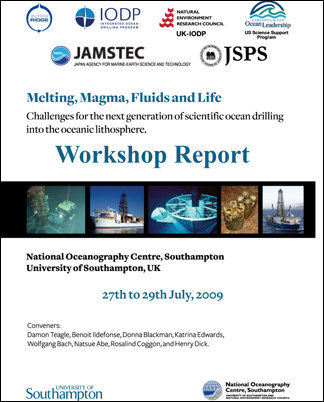Melting, Magma, Fluids and Life: Workshop for Scientific Ocean Drilling
July 27-29, 2009 – Southampton , UK
Convener: Donna Blackman

Overview
From its formation at mid-ocean ridges, to its recycling in subduction zones, the oceanic lithosphere serves as the major “process zone” for heat and material exchanges between Earth’s deep interior and the surface. Only within this thermally and hydrologically dynamic region is there direct interplay between mantle, crust, and ocean. The natural variability in thermal conditions associated with differences in accretionary magma supply and tectonic history fosters fascinating differences in the nature of hydrobio-geochemical interplay within the young (≲1 m.y.) lithosphere. Deep sea ecosystems thrive on the seafloor of oceanic spreading centers in zones with the highest thermal or chemical gradients, but the nature and extent of microbial life on/within the lower thermal and chemical gradients of aging ocean lithosphere (1-100 m.y.) remain unknown. Although the dominant fluid-rock reactions that occur during hydrothermal alteration of the ocean crust are well established, the magnitude of chemical exchange between the ocean lithosphere and the oceans remains poorly quantified principally because of our sparse and unrepresentative sampling of the ocean crust. Over the last decade or so, a major change in our understanding of the ocean crust has occurred with the discovery that crust formed at slow and ultraslow spreading ridges is extremely diverse, ranging from large areas of the oceans floored by altered mantle rock, to regions with a thick layered crust. Although ocean crust formation in the Pacific occurs at a vastly greater rate, the crust at slow and ultraslow spreading ridges will exchange with the oceans by very different reactions and is likely to play an important, hitherto unaccounted for, role in controlling ocean chemistry. This provides a new impetus for a major societal priority, which seeks to understand global chemical cycling and its impacts on climate change. To understand the major drivers of climate change it is crucial to quantify the sources, sinks, and pathways of heat and chemical transfer between the oceans and solid Earth. Only with these critical benchmarks can we confidently compare exchange fluxes with the ocean lithosphere with those from other components of the Earth system (e.g., rivers) that also affect ocean chemistry. A key outcome of this workshop was the formulation of integrative scientific questions and implementation approaches that will elucidate the role of ocean lithosphere processes within the broader Earth System. The focus is mostly on the igneous/metamorphic basement. There are three main aspects, each comprising geological, hydrological, chemical, and biological processes that are closely interdependent.
Workshop Report (pdf)
Conveners
Damon Teagle, University of Southampton
Natsue Abe, JAMSTEC
Wolfgang Bach, University of Bremen
Donna Blackman, Scripps Institution of Oceanography
Rosalind Coggon, Imperial College
Henry Dick, Woods Hole Oceanographic Institution
Katrina Edwards, University of Southern California
Benoit Ildefonse, Centre National de la Recherche Scientifique






